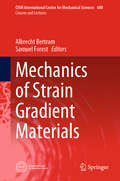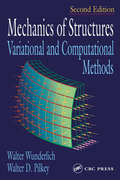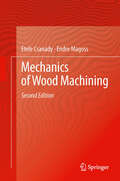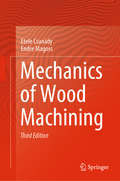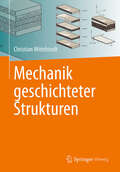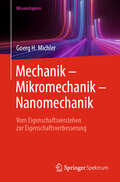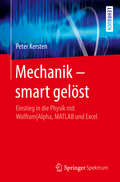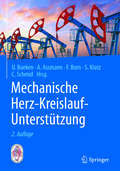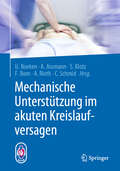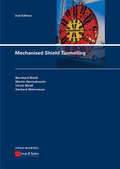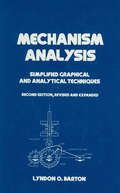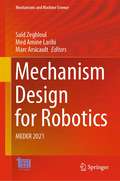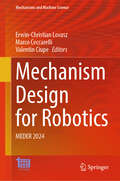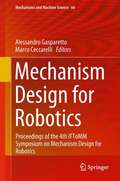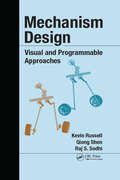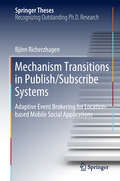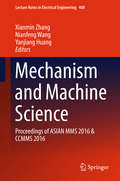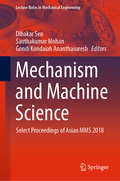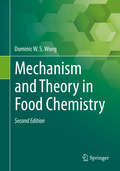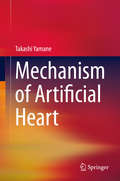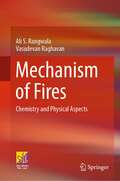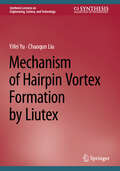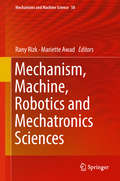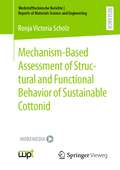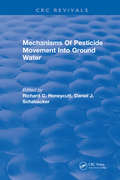- Table View
- List View
Mechanics of Strain Gradient Materials (CISM International Centre for Mechanical Sciences #600)
by Samuel Forest Albrecht BertramOver the past 50 years, strain gradient material theories have been developed for the continuum modeling of size effects in materials and structures in terms of their elasticity, plasticity and fracturing. This book puts forward a unifying perspective to combine existing theories involving the higher order gradient of the strain tensor, or of plastic strain. It begins by reviewing experimental findings on the existence (or non-existence) of size effects on the mechanics of materials. In turn, the book devises first, second and higher order strain gradient theories from general principles, and presents constitutive frameworks that satisfy thermodynamic requirements. The special case of strain gradient plasticity is then developed and illustrated via computational analyses of size effects on the plasticity of metals at small scales. In closing, the book explains the origin of gradient effects in the case of lattice structures by drawing on homogenization theory.
Mechanics of Structures: Variational and Computational Methods
by Walter D. Pilkey Walter WunderlichResoundingly popular in its first edition, the second edition of Mechanics of Structures: Variational and Computational Methods promises to be even more so, with broader coverage, expanded discussions, and a streamlined presentation.The authors begin by describing the behavior of deformable solids through the differential equations for the
Mechanics of Wood Machining
by Endre Magoss Etele CsanádyWood is one of the most valuable materials for mankind, and since our earliest days wood materials have been widely used. Today we have modern woodworking machine and tools; however, the raw wood materials available are continuously declining. Therefore we are forced to use this precious material more economically, reducing waste wherever possible. This new textbook on the "Mechanics of Wood Machining" combines the quantitative, mathematical analysis of the mechanisms of wood processing with practical recommendations and solutions. Bringing together materials from many sources, the book contains new theoretical and experimental approaches and offers a clear and systematic overview of the theory of wood cutting, thermal loading in wood-cutting tools, dynamic behaviour of tool and work piece, optimum choice of operational parameters and energy consumption, the wear process of the tools, and the general regularities of wood surface roughness. Diagrams are provided for the quick estimation of various process parameters. This book will be useful for scientists, graduate and postgraduate students, and practising engineers seeking a deeper understanding of physical phenomena associated with real woodworking processes.
Mechanics of Wood Machining
by Endre Magoss Etele CsanádyThe new edition of this textbook, while largely retaining the proven chapter structure of the previous editions, combines the quantitative, mathematical analysis of the mechanisms of wood processing with practical recommendations and solutions. It presents new theoretical and experimental approaches and offers a clear and systematic overview of the theory of wood cutting, thermal loading in wood-cutting tools, optimum choice of operational parameters, dynamic behavior of tool and workpiece, stability problems in wood machining, energy requirements, the wear process of tools and a unique analysis of surface roughness. In general, diagrams are provided to help quickly estimate various process parameters. As a modern and powerful tool, the process optimization procedure is also included, and amply demonstrated in worked-out examples. In this edition, new and updated material has been added in many sections: roughly a third of the book has been rewritten and a quarter of the figures are new. In addition, many figures have been revised for clarity. The authors are confident that this revised and expanded edition will continue to meet the needs of all those working in the field of wood machining.
Mechanik geschichteter Strukturen
by Christian MittelstedtDieses Buch bietet eine umfassende Darstellung der Statik und Dynamik geschichteter Strukturen und ist in fünf Abschnitte unterteilt. Nachdem im ersten Abschnitt die Grundlagen der Elastizitätstheorie und der Energiemethoden der Elastostatik sowie der Festigkeitsanalyse kurz eingeführt wurden, widmet sich der zweite Abschnitt den Grundlagen der Berechnung von geschichteten ebenen Strukturen, den sog. Laminaten. Der nachfolgende dritte Abschnitt behandelt das Stabilitätsverhalten solcher Laminate, wobei neben analytischen Lösungen auch Näherungsverfahren besprochen werden. Der vierte Abschnitt dieses Buchs geht auf spezielle Themen bei der Behandlung geschichteter Strukturen ein, bevor der fünfte und letzte Abschnitt geschichteten Stäben und Balken gewidmet ist. Dieses Buch richtet sich an Studierende an Fachhochschulen und Universitäten, aber auch an Ingenieurinnen und Ingenieure in der Praxis sowie an Forscherinnen und Forscher der Ingenieurwissenschaften.
Mechanik – Mikromechanik – Nanomechanik: Vom Eigenschaftsverstehen zur Eigenschaftsverbesserung
by Goerg H. MichlerUm das mechanische Verhalten von Werkstoffen einerseits besser zu verstehen und andererseits gezielt verbessern zu können, müssen die Prozesse und Mechanismen, die bei mechanischer Belastung im Material in Abhängigkeit von den Materialstrukturen ablaufen (die sog. „Struktur- Eigenschafts-Korrelationen“), bekannt sein. Grundlegend sind die Prozesse auf mikro- und nanoskopischer Größenebene, d.h. im Größenbereich von 0,1 mm bis herab zu 0,1 nm (d.h. sog. Mikro- und Nanomechanik). Der Autor charakterisiert anschaulich diese mikro- und nanomechanischen Mechanismen mit aussagefähigen Schemata und Bildern auf der Grundlage hauptsächlich von elektronenmikroskopischen Analysen. Neben allgemeingültigen Prozessen und Mechanismen wird auch auf materialspezifische Effekte (z.B. Crazes, Chevrons, Dünnschichtfließen) eingegangen.Die Produktfamilie WissensExpress bietet Ihnen Lehr- und Lernbücher in kompakter Form. Die Bücher liefern schnell und verständlich fundiertes Wissen.
Mechanik – smart gelöst
by Peter KerstenDieses Buch bietet Studierenden in MINT-Fächern eine optimale Hilfestellung beim Erlernen der Grundlagen der Physik. Typische Aufgaben der Mechanik werden dabei Schritt für Schritt erklärt und mit Hilfe leistungsstarker Software aus den Bereichen Tabellenkalkulation, Computeralgebra und technisch-wissenschaftlichem Rechnen gelöst. Die dabei verwendeten Programme (Excel®, der Internetdienst Wolfram|Alpha® sowie die Software MATLAB®) sind sowohl auf Desktop-Rechnern, als auch als Apps auf mobilen Endgeräten wie Smartphones oder Tablets verfügbar – und damit immer schnell zur Hand. Das Fähigkeit mit diesen Programmen zu arbeiten kann auch im weiteren Studienverlauf und später in der beruflichen Praxis von großen Nutzen sein. Nach einer kompakten Einführung in mathematische Methoden und die verwendeten Programme deckt das Buch dabei die Bereiche der klassischen Mechanik mit den Teilgebieten Kinematik und Dynamik ab und liefert somit eine ideale Unterstützung für Einführungsvorlesungen in Physik an Hochschulen. Allen Studierenden, die sich beim Lösen von Aufgaben in der Physik schon einmal eine kleine Hilfestellung gewünscht haben, die einfach mal einen Funktionsverlauf visualisieren, eine Gleichung ohne Papier und Bleistift lösen oder das eigene Rechenergebnis überprüfen möchten, wird das vorliegende Buch ein praktischer und wertvoller Begleiter sein.
Mechanische Herz-Kreislauf-Unterstützung
by Stefan Klotz Udo Boeken Alexander Assmann Frank Born Christof SchmidDer aktuelle Stand der mechanischen Herz-Kreislauf-Unterstützung ist in übersichtlicher Form in diesem Buch zusammengefasst. Die einzelnen verwendeten Systeme werden ebenso von Experten in Wort und Bild dargestellt wie die Indikationsstellung, die Nachsorge und mögliche Komplikationen. Neu in der 2., durchgehend aktualisierten Auflage sind Kapitel zur psychologischen Versorgung von VAD-Patienten, zur ECLS/ECMO bei Kindern und zu aktuellen Weiterentwicklungen im VAD-, aber auch TAH-Sektor; das Kapitel zum Komplikationsmanagement wurde erweitert.
Mechanische Unterstützung im akuten Kreislaufversagen
by Stefan Klotz Udo Boeken Alexander Assmann Frank Born Christof Schmid Andreas RiethZur Überbrückung eines akuten Kreislaufversagens wurden in den letzten Jahren unterschiedliche Unterstützungssysteme mit spezifischen Vorzügen und Nachteilen entwickelt. Das Prinzip, die Indikationen zur Anwendung und mögliche Risiken und Komplikationen aller angewandten Systeme (IABP, Impella, TandemHeart, Zentrifugalpumpen, va-ECMO) sind anschaulich und mit zahlreichen Abbildungen von Experten beschrieben. Grundlagenthemen wie die Pathophysiologie des Schocks und das Gerinnungsmanagement werden ebenso berücksichtigt wie spezielle Anwendungen bei Kindern oder für den Patiententransport.
Mechanised Shield Tunnelling
by Martin Herrenknecht Bernhard Maidl Gerhard Wehrmeyer Ulrich MaidlMechanised shield tunnelling has developed considerably since the publication of the first edition of this book. Challenging tunnel projects under difficult conditions demand innovative solutions, which has led to constant further development and innovation in process technology, constructions operations and the machines and materials used. The book collects the latest state of technology in mechanised shield tunnelling. It describes the basics of mechanised tunnelling technology and the various types of machines and gives calculation methods and constructural advice. Further chapters cover excavation tools, muck handling, tunnel support, surveying and steering as well as workplace safety. There is also detailled information about contractual aspects and process controlling.
Mechanism Analysis: Simplified and Graphical Techniques, Second Edition, (Mechanical Engineering)
by Lyndon O. BartonThis updated and enlarged Second Edition provides in-depth, progressive studies of kinematic mechanisms and offers novel, simplified methods of solving typical problems that arise in mechanisms synthesis and analysis - concentrating on the use of algebra and trigonometry and minimizing the need for calculus.;It continues to furnish complete coverag
Mechanism Design for Robotics: MEDER 2021 (Mechanisms and Machine Science #103)
by Saïd Zeghloul Med Amine Laribi Marc ArsicaultThis book presents the proceedings of the 5th IFToMM Symposium on Mechanism Design for Robotics, MEDER 2021, held in Poitiers, France, 23–25 June 2021. It gathers contributions by researchers from several countries on all major areas of robotic research, development and innovation, as well as new applications and current trends. The topics covered include: theoretical and computational kinematics, mechanism design, experimental mechanics, mechanics of robots, control issues of mechanical systems, machine intelligence, innovative mechanisms and applications, linkages and manipulators, micro-mechanisms, dynamics of machinery and multi-body systems. Given its scope, the book offers a source of information and inspiration for researchers seeking to improve their work and gather new ideas for future developments.
Mechanism Design for Robotics: MEDER 2024 (Mechanisms and Machine Science #166)
by Erwin-Christian Lovasz Marco Ceccarelli Valentin CiupeThis book presents the proceedings of the 6th IFToMM Symposium on Mechanism Design for Robotics (MEDER), held in Timişoara, Romania, 27–29 June 2024. It gathers contributions by researchers from several countries on all major areas of robotic research, development and innovation, as well as new applications and current trends. The topics covered include: theoretical and computational kinematics, mechanism design, experimental mechanics, mechanics of robots, control issues of mechanical systems, machine intelligence, innovative mechanisms and applications, linkages and manipulators, micro-mechanisms, dynamics of machinery and multi-body systems. Given its scope, the book offers a source of information and inspiration for researchers seeking to improve their work and gather new ideas for future developments.
Mechanism Design for Robotics: Proceedings Of The 4th Iftomm Symposium On Mechanism Design For Robotics (Mechanisms and Machine Science #66)
by Marco Ceccarelli Alessandro GasparettoThis volume contains the Proceedings of the 4th IFToMM Symposium on Mechanism Design for Robotics, held in Udine, Italy, 11-13 September, 2018. It includes recent advances in the design of mechanisms and their robotic applications. It treats, among others, the following topics: mechanism design, mechanics of robots, parallel manipulators, actuators and their control, linkage and industrial manipulators, innovative mechanisms/robots and their applications. This book can be used by students, researchers and engineers in the relevant areas of mechanisms, machines and robotics.
Mechanism Design: Visual and Programmable Approaches
by Kevin Russell Qiong Shen Raj S. SodhiIn the field of mechanism design, kinematic synthesis is a creative means to produce mechanism solutions. Combined with the emergence of powerful personal computers, mathematical analysis software and the development of quantitative methods for kinematic synthesis, there is an endless variety of possible mechanism solutions that users are free to e
Mechanism Transitions in Publish/Subscribe Systems
by Björn RicherzhagenThis book reports on a novel concept of mechanism transitions for the design of highly scalable and adaptive publish/subscribe systems. First, it introduces relevant mechanisms for location-based filtering and locality-aware dissemination of events based on a thorough review of the state-of-the-art. This is followed by a detailed description of the design of a transition-enabled publish/subscribe system that enables seamless switching between mechanisms during runtime. Lastly, the proposed concepts are evaluated within the challenging context of location-based mobile applications. The book assesses in depth the performance and cost of transition execution, highlighting the impact of the proposed state transfer mechanism and the potential of coexisting transition-enabled mechanisms.
Mechanism and Machine Science
by Xianmin Zhang Nianfeng Wang Yanjiang HuangThese proceedings collect the latest research results in mechanism and machine science, intended to reinforce and improve the role of mechanical systems in a variety of applications in daily life and industry. Gathering more than 120 academic papers, it addresses topics including: Computational kinematics, Machine elements, Actuators, Gearing and transmissions, Linkages and cams, Mechanism design, Dynamics of machinery, Tribology, Vehicle mechanisms, dynamics and design, Reliability, Experimental methods in mechanisms, Robotics and mechatronics, Biomechanics, Micro/nano mechanisms and machines, Medical/welfare devices, Nature and machines, Design methodology, Reconfigurable mechanisms and reconfigurable manipulators, and Origami mechanisms. This is the fourth installment in the IFToMM Asian conference series on Mechanism and Machine Science (ASIAN MMS 2016). The ASIAN MMS conference initiative was launched to provide a forum mainly for the Asian community working in Mechanism and Machine Science, in order to facilitate collaboration and improve the visibility of activities in the field. The series started in 2010 and the previous ASIAN MMS events were successfully held in Taipei, China (2010), Tokyo, Japan (2012), and Tianjin, China (2014). ASIAN MMS 2016 was held in Guangzhou, China, from 15 to 17 December 2016, and was organized by the South China University under the patronage of the IFToMM and the Chinese Mechanical Engineering Society (CMES). The aim of the Conference was to bring together researchers, industry professionals and students from the broad range of disciplines connected to Mechanism Science in a collegial and stimulating environment. The ASIAN MMS 2016 Conference provided a platform allowing scientists to exchange notes on their scientific achievements and establish new national and international collaborations concerning the mechanism science field and its applications, mainly but not exclusively in Asian contexts.
Mechanism and Machine Science: Select Proceedings of Asian MMS 2018 (Lecture Notes in Mechanical Engineering #2)
by Gondi Kondaiah Ananthasuresh Dibakar Sen Santhakumar MohanThis volume presents select papers from the Asian Conference on Mechanism and Machine Science 2018. This conference includes contributions from both academic and industry researchers and will be of interest to scientists and students working in the field of mechanism and machine science.
Mechanism and Theory in Food Chemistry, Second Edition
by Dominic W.S. WongFor the first time in over twenty-five years, this unique and popular textbook on food chemistry mechanism and theory has received a full update. Emphasizing the underlying chemical reactions and interactions that occur in foods during processing and storage, this book unifies the themes of "what", "how" and "why" in the language of equations, reactions and mechanisms. This book is the only work which provides in-depth focus on aspects of reaction mechanisms and theories in the chemistry of food and food systems. With more than 500 chemical equations and figures, this book provides unusual clarity and relevance, and fills a significant gap in food chemistry literature. It is a definitive source to consult regarding the important mechanisms that make food components and reactions tick.Mechanism and Theory in Food Chemistry has been a popular resource for students and researchers alike since its publication in 1989. This important new edition contains updates on the original text encompassing a quarter century of advances in food chemistry. Many parts of the original chapters are revised to make for smoother navigation through the subjects, to better explain the underlying chemistry concepts and to fulfill the need of adding topics of emerging importance. New sections on fatty acids, lipid oxidation, meat, milk, soybean and wheat proteins, starch and many more have been incorporated throughout the revision. This updated edition provides an excellent source of all the important chemical mechanisms and theories involved with food science.
Mechanism of Artificial Heart
by Takashi YamaneThis book first describes medical devices in relation to regenerative medicine before turning to a more specific topic: artificial heart technologies. Not only the pump mechanisms but also the bearing, motor mechanisms, and materials are described, including expert information. Design methods are described to enhance hemocompatibility: main concerns are reduction of blood cell damage and protein break, as well as prevention of blood clotting. Regulatory science from R&D to clinical trials is also discussed to verify the safety and efficacy of the devices.
Mechanism of Fires: Chemistry and Physical Aspects
by Ali S. Rangwala Vasudevan RaghavanThis textbook on fire dynamics provides a comprehensive description of fuels involved in fires, definitions related to fire, thermodynamics for fire calculations, basics of transport processes and fundamental aspects of combustion related to fire, physical descriptions of premixed and non-premixed flames, detailed analysis of the characteristics of fires from solid and liquid fuels, including ignition, spread and burning rates and physical aspects of fire plumes, compartment fires and dust fires. The contents also highlight fundamental aspects related to the evaporation of liquid fuels and pyrolysis of solid fuels which are explained with simplified mathematical expressions. The book includes pedagogical features such as worked examples to illustrate mathematical calculations involved in fire analysis and end-of-chapter review questions. This book proves useful for students, researchers and industry professionals alike.
Mechanism of Hairpin Vortex Formation by Liutex (Synthesis Lectures on Engineering, Science, and Technology)
by Chaoqun Liu Yifei YuThis book presents the importance of the mechanism of hairpin vortex formation to understanding flow transition, turbulence, and flow control. This book blends direct numerical simulation (DNS) and mathematical analysis with experiments to create a foundation for understanding turbulence. The authors discuss hairpin vortex as a main component of transitional flow and turbulent flow. In addition, Liutex is utilized and described as a theoretical system that presents valid tools for turbulence research. Readers are exposed to understanding 3D and non-linear instability; the Lambda vortex formation; sweeps, ejections, and shear instability; the Kelvin-Helmholtz instability and vortex ring formation; and turbulence generation and sustenance.
Mechanism, Machine, Robotics and Mechatronics Sciences (Mechanisms and Machine Science #58)
by Mariette Awad Rany RizkThis volume contains the Proceedings of the First International Congress for the Advancement of Mechanism, Machine, Robotics and Mechatronics Sciences (ICAMMRMS-2017), held in Beirut, Lebanon, October 2017. The book consists of twenty papers in six different fields covering multiple angles of machine and robotics sciences: mechanical design, control, structural synthesis, vibration study, and manufacturing.This volume is of interest to mechanical as well as electrical engineers.
Mechanism-Based Assessment of Structural and Functional Behavior of Sustainable Cottonid (Werkstofftechnische Berichte │ Reports of Materials Science and Engineering)
by Ronja Victoria ScholzRonja Victoria Scholz assesses the performance of cellulose-based Cottonid for implementation as sustainable construction material. Quasi-static and fatigue tests are performed in varying hygrothermal test conditions using mechanical testing systems in combination with integrable climate chambers. To investigate humidity-driven actuation properties, customized specimen holders are designed. Accompanying microstructural in situ experiments in analytical devices enable a profound understanding of effective material-specific damage and failure mechanisms. The findings are transferred into strength-deformation diagrams as well as Woehler curves, which enable a comparative evaluation of several process-related and environmental influencing factors and can directly be used for dimensioning of Cottonid elements for structural applications. The interpretation of thermoelastic material reponse during loading is used as scientific value for lifetime prediction. Comprehensive investigations on industrial standard materials as well as structurally optimized Cottonid variants provide a scientific basis for categorizing material’s structural and functional performance towards common technical plastics and wood.
Mechanisms Of Pesticide Movement Into Ground Water
by R. HoneycuttThis book is devoted to exploring the mechanism of pesticide movement into groundwater. It describes how pesticides enter ground water/drinking water systems and how regulatory decisions based on these mechanisms will affect the use of pesticides. Experimental results, models, and industry and regulatory perspectives are covered.
